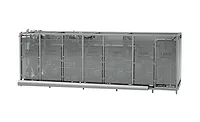ZAP! Better-tasting UHT milks!

In a project managed by Dairy Management Inc., researchers at the Logan, Utah-based Dairy Center found that passing electrical current through pasteurized milk not only destroys virtually all bacteria present, but also delivers a fresher tasting product with an extended shelf life.
UHT processes that are currently in commercial use typically rely on either indirect heat exchange through a metal plate or the direct addition of steam into the milk. While the resulting UHT-processed milk is gaining favor in other parts of the world, U.S. consumers accustomed to the ready availability of fresh milk have been slow to accept it, in part because of its cooked flavor. "Heat exchange is a physical process that simply demands time," said co-researcher Donald McMahon of Utah State University. "The longer that milk is exposed to those high temperatures, the more that cooked flavors develop in the end product. Direct heating with steam is quicker, but the added water has to be removed by vacuum evaporation during cooling."
By comparison, the use of electric current -- known as electroheating -- involves a fast, direct-heat application. "By passing the electrical current directly through the milk itself, we can reach UHT levels in a fraction of a second, rather than minutes,'' said McMahon. "This quicker heating is the key to producing a fresh tasting product."
Current passes through the milk as a result of applying voltage across electrodes that have been placed in contact with the product, according to Raztek Corp., developer of the process. With more conventional heating methods, the temperature of the wall or tube where the product is heated must be significantly higher than the temperature of the product in order to reach the required temperature to pasteurize or sterilize the product. This increases the risk of fouling and scorching of the product near the walls and leads to the formation of off-flavors. Because electroheating is based on passage of electricity through a food product, the electrical power is translated into heat as it passes along the flow line of the fluid. This allows rapid, uniform heating to occur without the risk of overheating or burning the product.
For commercial producers, electroheating also has the advantage of ready regulatory acceptance. While researchers are continuing to explore a variety of nonthermal ways to extend milk's shelf life, these experimental technologies carry a scientific burden of proof. Electroheating, on the other hand, provides heat sterilization at temperatures identical to current UHT-processed milk. Hence, electroheating milk could meet milk regulatory and safety compliances while extending the product's shelf life.
The real test of electroheated milk is consumer acceptance. According to Dairy Management Inc., consumers participating in test trials preferred the taste of the electroheated milk to a commercial UHT-processed milk sample by a margin of two to one.
McMahon believes that taste is the key to consumer acceptance of longer-lasting milk products. And given industry trends, longer shelf life may be critical to the success of U.S. dairy producers. "Dairy companies are consolidating to improve their competitive position in a global market," McMahon said. "We can expect to see that trend continue for the foreseeable future. With consolidation, distribution chains become longer. So to meet consumer expectations for fresh product, more and more companies will have to look at ways to extend shelf life."
Looking for a reprint of this article?
From high-res PDFs to custom plaques, order your copy today!





